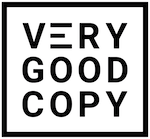
“Ow!”
I looked at my finger. It was bleeding. “Dang,” I said. “Shit.”
“Thorn?” Kels said. I stuck my finger in my mouth and nodded. It’s getting colder in Chicago. Last weekend my wife asked me to bring the lemon tree inside. It’s been in a pot on my deck all summer. We’ve never kept it in the house.
That night, we went to the library with our son.
“We should see if they have any books on keeping houseplants,” Kels said.
People make decisions in one of two ways:
The hard way and the easy way.
The hard way is called Systematic Processing, fancy for “critical thinking.” It involves carefully and deliberately analyzing information to determine if it’s valid and reliable. But critical thinking takes time, of course, and energy. It burns calories. We can only do it for so long before we tire out.

Never miss a VeryGoodCopy Micro-Article: SUBSCRIBE
The easy way is called Heuristic Processing — “heuristics” for short — which means making decisions based on cues and shortcuts.
“Excuse me,” I said.
The librarian looked up.
“Do you have any books on houseplants?”
“Oh,” she said. “Those are in the horticulture section.” She stood up. “I’ll show you.” We walked over together. “This shelf,” she pointed, “and this one,” she pointed lower, “are all houseplant books.”
“Thank you,” I said. The librarian smiled and walked away. I scanned the shelves. There were so many books. I grabbed three — two short paperbacks and a hardcover, thick, like a textbook — then backtracked to my family.
Our brains developed heuristics to avoid thinking.
Because thinking is taxing. And thinking deeply can be literally painful. So over thousands of years, humans evolved these heuristics, these cognitive workarounds and timesavers. And now, today, copywriters and marketers use them to influence the masses.
Enter: Length Implies Strength Heuristic, or LISH, the assumption that more words = more substance.
For example, a 200-page book seems more comprehensive, and therefore credible, than a 60-page book on the same subject.
I found Kels on the floor with Beau, reading.
“I got three,” I said.
She looked up at the books. I looked down at my watch. “The library’s closing,” I said. “Wanna just get all three?”
“No, this one should do it,” Kels said, gripping up the hardcover.
Years ago, I used LISH on VeryGoodCopy.
I collated a “wall” of testimonials on the homepage. Conversions shot up.
My friend and fellow writer, Justin Welsh, also saw remarkable results when he published a testimonial wall on his course landing page: “My conversion rate has gone from that low-to-mid 1 percent up to about 3.6 percent,” he said. “So it has literally almost 3X the conversions.”
This is almost certainly a product of the LISH effect. It’s what happens when people see an abundance of proof — many testimonials, many words — and think: “There must be something to this. So many capable people can’t be wrong.”
Try it.
Try adding a wall of testimonials to your landing page. It may trigger the LISH effect.
And this could triple your conversion rate, too
P.S.
If you’re enjoying VeryGoodCopy, please feel free to leave a testimonial 🙂

LEARN TO PERSUADE
✅ Join thousands of email subscribers
✅ Less than 0.4% of readers unsubscribe
✅ Never miss a Micro-Article or -Interview
✅ Get instant email access to VGC's founder
✅ Be first in line to get new, free Micro-Courses
DRAYTON BIRD
Global Creative Director @ Ogilvy & Mather
BEN SETTLE
Email Marketing Master
KIM KRAUSE SCHWALM
A-List Direct Response Copywriter
RYAN BONNICI
Forbes 26th Most Influential CMO
SCOTT DIKKERS
Founding Editor @ The Onion 🧅
LISA PIERSON
Partner @ CopyHackers Agency
JUSTIN WELSH
SaaS Advisor & Writer
GODARD ABEL
CEO @ G2.com
DAVID GARFINKEL
A-List Direct Response Copywriter
JORGE SELVA
Director of Growth @ Help Scout
ADAM GOYETTE
Chief Marketing Officer @ Help Scout
TYLER J. KOENIG
Conversion Copywriter
TOMMY WALKER
Editor-in-Chief @ Shopify Plus & CXL
JASON VANA
Founder @ SHFT Marketing
JUSTIN BLACKMAN
Founder @ Pretty Fly Copy
CAMILLE TRENT
Managing Editor @ MarketerHire
NIKHIL NARAYANAN
Creative Director @ Ogilvy & Mather
EDEN BIDANI
Copywriter @ Greenlight Copy
MARK KILENS
VP of Content @ Drift
Nice notes from happy readers:
































